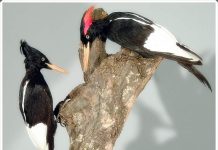DESCRIPTION
The Eastern Whipbird is an insectivorous passerine bird that makes a recognizable sound in forests of eastern Australia. Unlike the Western Whipbird, the Eastern male does not share incubation and brooding but does feed the female on the nest. Both sexes feed the chicks, which are initially covered in fine black down. The young bird leaves the nest before they can fly, and hide-perched still in the undergrowth-for a week or so until they can.
During this stage, their otherwise shy and elusive parents become fearless in their defense. Apart from the endemic wedge bills, the Australian Whipbirds have no obviously close relatives among songbirds except, perhaps, a ‘green babbler’. Androphobus Viridis in the montane rainforests of western New Guinea. It nonetheless lacks one of the distinctive features of Whipbirds, an un-notched tip to the upper mandible.
Eastern Whipbird Call
The resounding whipbird call of the eastern whipbird (Psophodes olivaceus, a common year-round sound in the wet gully forests of coastal eastern Australia, seems to have two functions: to signal territory and to identify the caller’s position. Thus, both male and female usually combine to produce the call antiphonally, in a call-and-answer sequence: the male contributes the long whistled whip crack, and the female the two or three concluding chirrups. In this way, they keep in touch as they forage up to 30 meters apart through dense forest underbrush.
The male’s call does not vary, but the female’s response alters from district to district. Established pairs hold permanent territories of about five-ten hectares in which they, with their young of the year, feed actively in the litter of the forest floor. They fly little, tail-fanned, and forage mostly on foot throughout the day, turning over leaf litter with their powerful feet to unearth a wide range of insects and their larvae. They also search within shrubberies and fallen logs, their noisy rustling interspersed with repeated chuck, chuck, chuck calls.
IDENTIFICATION
Adults: Both sexes are similar. However, the head and crest are black; with the back, wings, and tail being olive-green, and tail feathers tipped white except in the in the central one-two pairs. Cheeks are broadly white, extending onto the throat. Center throat and breast black, grading to mauled white on belly and dusky olive on flanks and undertail. The eye is red-brown along the bill and black. The feet are red-brown to dusky. Moreover, the race in northeastern Queensland (Cooktown-lngham) is only smaller, with a disproportionately short tail.
IMMATURES: The immature are duller and grayer-breasted and bellied, without white cheeks, until their second year.
VOCALS
The Eastern Whipbird call is repeated chucks in contact, sometimes harsh scolds. The Eastern Whipbird SONG is antiphonal, in a call-and-answer sequence by male and (usually) female. The male sings a series of low whistles swelling into a long-drawn crescendo on the same pitch, ending with the swirling upsweep of the whip crack. The female responds at once with several sharp chirrups: chooo-chooo or chooo-eee. The Eastern Whipbird sounds have been used in numerous movies.
NESTING
The birds breed in July and January. Nest a shallow, bulky cup, of long, loosely interwoven twigs; lined with rootlets and fiber; placed in the thick foliage of dense shrub or vine in the undergrowth, 0.5–4 m above ground.
EGGS:
The female Eastern Whipbird incubates the eggs alone, but the male feeds her while she is in the nest. Their whip-crack calls are often heard in wet forests. two; pale blue with spots and irregular marks of black and underlying lilac; oval, about 28 x 20 mm. Incubation: 17–18 days, for females, often laying in the afternoon. Young fledge in 10–11 days.
DISTRIBUTION
Eastern Whipbird ranges are from south of Melbourne to north of Cairns. These birds are, sedentary, shy, indefinable, and well hidden away, and though habitually heard, they are rarely ever seen. Mostly thickets in the rainforest and wet sclerophyll, brushes of coastal eastern Australia; also in dense wet heaths and moist gullies!
SIZE
Eastern Whipbird size is about 250–300 mm in length, with the average weight being 1.6–2.5 oz.
OTHER NAMES
Coach Whipbird, SwckWhipbird, Whipbird.
SUB-SPECIES
So far, two sub-species have been recognized.
-
P. o. lateralis
-
P. o. olivaceus

The Eastern Whipbird is an insectivorous passerine bird that is a recognizable sound in forests of eastern Australia. Photo Credit – Greg Miles from Australia via Wikipedia Related Reading – Common Stonechat






